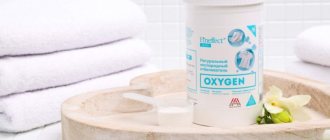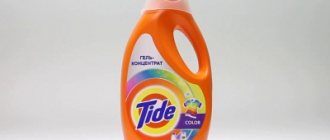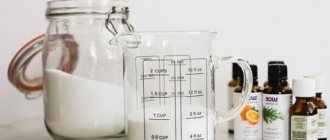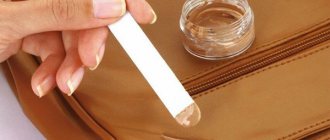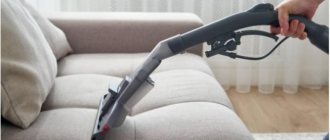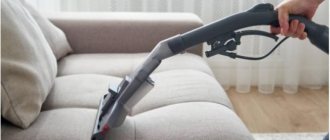A good fabric softener can restore the main consumer qualities of clothing and household fabric products. But in order not to harm your wardrobe items and yourself, you need to know the nuances of dosages, composition and methods of using washing substances.
The editors of the Yanashla website will tell you how to choose an effective and safe product for improving the properties of tissues. In our review of the best fabric softeners for 2022, the reader will find all the information they need to make a decision on a specific laundry product. The rating includes rinses with various forms of packaging, expensive and budget popular models of products.
What is fabric softener
Gradually, any, even the highest quality products lose their original appearance. The material becomes rougher and the item stays in the closet longer because it is no longer as pleasant to wear. The reasons are the following factors:
- increased water hardness;
- mechanical impact of an automatic machine;
- influence of detergents;
- incorrect wet cleaning mode.
Synthetic fabrics begin to “stick” to the body and attract dust to themselves, becoming electrified. A high-quality fabric softener can overcome all these troubles. With it, towels will no longer feel “wooden”, and your favorite clothes will again begin to pleasantly envelop, and not rub the skin, seeming like rough burlap.
Action of the product
The substance contains cationic surfactants, which settle on the material, creating a kind of coating in the manner of an invisible film.
Conditioner effect:
- softening;
- repels dirt and moisture;
- simplification of ironing;
- maintaining color saturation;
- elimination of static;
- pleasant smell immediately after washing and for a long time when stored in a closed space.
Some products contain silicone. It maintains the effect for a longer period, and the item looks like new longer.
This is interesting: often fabric softeners are labeled “rinse aid” because the product is released from the dispenser during the rinse cycle, rather than the main wash.
You should be careful when using any chemical cleaning products. This product cannot be used with all types of fabric.
What things is it suitable for?
You must follow the washing rules for each individual item. Typically, recommendations on this topic appear on a special label that is equipped with all fabric products. If the tag indicates that machine washing is allowed, then you can use conditioner.
Features of the interaction of the active substances of the rinse aid with certain materials:
- Silk products acquire unsightly smudges. They will disappear after the next wash with a special product for such things or will remain forever if a concentrate was used.
- Shapewear loses its elasticity and may not fit your figure.
- Outerwear will lose its water-repellent properties.
- Products made from breathable fabrics, microfiber and Gore-tex are strictly prohibited from being washed using any conditioners or other auxiliary substances. Otherwise, the item will lose its basic functions and become useless.
At first glance, it seems that fabric softeners are very harmless and cannot harm. But that's not true. If the label prohibits the use of air conditioners, it cannot be ignored, otherwise the damage done will be irreparable.
Why it's worth a try
Most housewives consider this purchase a pointless waste of money. Others do not consider such a purchase because of the possible harm of the chemical components. Or the most banal reasons: they cannot tolerate additional odors from laundry, they do not see the point in the product as such.
Despite all the considered nuances, the use of fabric softeners has very significant advantages.
Firstly, fabric products become soft and delicate.
Secondly, you can forget about the fact that your favorite sweater is “electric”, because most rinses remove static from clothes.
Thirdly, ironing things is much faster and more comfortable. And the appearance of the clothes remains in neat condition for a long time.
Fourthly, the wear resistance of the material increases. Creases, pilling, scuffs, dull color from repeated washings - all this can be avoided for a long time.
Solving the security issue is quite simple. How to choose a rinse aid? We simply buy those products that do not contain the dangerous components discussed above. At the same time, we make sure that the surfactant content is at the level of 5% -15%. If it is lower, there will be no effect when washing, therefore, “money down the drain.” If it is higher, then there is harm from the use of detergents.
Why do you need fabric conditioner?
Using special substances to improve the condition of fabrics and increase the comfort of wearing them is not something special in our time. You want to extend the “life” of your favorite item and wear it more often.
Moreover, after conditioning, the fabric is easier to iron, and the fresh smell lingers on the material for a long time. Application is possible for both simple and complex and combined fabrics. The main thing is to choose and use the product correctly.
What things is it suitable for?
The machine washable icon on the label indicates that you can use conditioner when cleaning the item. The softener has a positive effect on products made from cotton, linen, synthetics, and wool. But it is contraindicated for some types of fabrics:
- There will be streaks or stains on the silk.
- Shapewear will be shapeless.
- Microfiber cleaning cloths will lose their ability to hold dust in the fibers and become useless.
- Sportswear will lose its absorbent properties. Once it stops absorbing moisture, the fabric will quickly become damp and smell unpleasant.
- Things with water-repellent impregnation, like fire-resistant products, do not require the use of conditioner, which neutralizes their beneficial properties.
How to add when hand washing
After the basic manipulations of wet cleaning the item, you need to fill a bowl with clean water for a secondary rinse. Add the required amount of product there. The exact ratios are indicated on the conditioner packaging. The original cap on the mouthwash bottle is most often used as a measuring cup.
Soak the laundry for 10 minutes in the resulting solution. Wring out and hang to dry.
Important: if you ignore the dosage recommendations indicated in the instructions for the product, the effect will be insignificant or excessive. The fabric may react in unexpected ways, becoming sticky or unpleasant to the touch. Skin irritation will appear.
When should it not be used?
It is not recommended to use even the best conditioner in the following cases:
- when washing silk, the product can cause streaks and ruin the fabric;
- for woolen products of large knitting;
- when washing shapewear and nylon products;
- for outerwear.
You should use products with caution, especially flavored ones, if you are prone to allergies. For people with sensitive skin, it is better to use a rinse aid for children's clothes.
How to add during automatic washing
In the case of a typewriter, everything is even simpler. Simultaneously with loading the powder and bleach, the required amount of conditioner is added to a special compartment. The “smart” unit will add the amount of substance allocated to it at the right time, namely during the rinsing cycle.
Before adding conditioner, you need to study the packaging to find out the permissible dosage of the selected product. As a rule, when the drum is fully loaded at 5 kg, 1 cap of rinse aid is used (for a stable and long-lasting effect). For smaller quantities, use half a measuring cup.
Important: the concentration of surfactants varies, so you should always pay attention to the recommendations on the packaging.
Types of funds and their differences
When purchasing a product to improve the condition of tissues, you should pay attention not only to the price and reputable brand, but also to the composition of the substance. Even if the label does not specify whether it is a concentrate, a siliconized rinse aid, or the like, you can learn from the ingredients about the main action and features of the substance.
What to pay attention to:
- The composition should include no more than 5 components at a time. If there are more of them, it means that the product contains harmful components and is not recommended for use when cleaning things for children and allergy sufferers. Usually there are: surfactants, natural fragrances, silicones, preservatives.
- The container needs to be shaken. The appearance of foam indicates low quality of the product or its expiration date.
- Surfactant can be from 5 to 15%. But some conditioners use different surfactants, and the total amount may be higher.
- Products containing benzyl acetate, terpineol and chloroform cause dermatological reactions similar to allergic ones. They are not safe for health.
- The presence of cationic surfactants neutralizes active substances harmful to the body that remain on clothes after washing.
- Flavors can be natural or artificial. But both of them, in large quantities, can cause a respiratory allergic reaction or suffocation.
- Silicone - gives things water-repellent or absorbent properties. Depends on other components.
- Dyes do not affect the color of the laundry and are intended solely to give a pleasant shade to the substance.
- Preservatives are necessary for long-term storage of the air conditioner after opening the package.
- A-terpineol is used to add lilac flavor, but may cause depression due to its central nervous system depressant.
- Benzyl alcohol - used to give the product a jasmine scent. Causes dizziness and nausea.
- Ethanol provokes blurred vision and disrupts mental activity.
- Chloroform is a CNS depressant.
- Linalool makes the mouthwash smell like lilies of the valley, but causes problems with muscle coordination and, in rare cases, causes cancer of the reproductive system.
This is interesting: it happens that a washed item lies in a closed space for a long time, and then an unpleasant, pungent odor is felt from it. This is due to excess washing powder. This will not happen when using baby detergents to wet clean clothes.
When choosing a quality product that does not include components hazardous to health, you still need to strictly follow the correct dosage. Excess surface active substances will not benefit either the tissue or the person.
There is a separate classification of air conditioners. They differ in their main components and actions.
Concentrates
In such products the amount of active substances is greater than in conventional ones, therefore their use is more economical - the dosage is reduced. This rinse aid does not need to be diluted (it will not thicken over time) and is poured into the washing machine compartment, as it is immediately ready for use.
The composition does not differ from conventional rinses, but the increased amount of active substances has increased effectiveness.
Important: Handle with care. Surfactants tend to accumulate on human tissues and organs, causing diseases and poor health. This happens due to an excess of the substance on the material of clothing or bedding that is constantly in contact with the skin. The amount of surfactant should be from 5 to 15%.
Children's
Used for washing items that come into contact with the delicate and sensitive skin of a child. They are usually hypoallergenic, have a small dosage and are harmless. Fragrances are practically not used, so the clothes will not acquire a special smell, but they will not “suffocate” when stored in a closet.
What should be in a children's conditioner:
- no more than 5% surfactant;
- absence of any fragrances;
- soft base without chloroform and other harmful substances;
- certificate according to GOST;
- age marking.
The high price of rinses indicates that the product does not contain cheap preservatives and thickeners that are harmful to the child.
Balms
A kind of analogue of a children's air conditioner. The complex substance contains fabric care additives. As a rule, it exudes the finest aroma. Does not irritate even hypersensitive skin. After washing, the laundry does not smell like conditioner, becomes unusually soft, and fewer pills form. The product looks like new longer. It costs more than a regular mouthwash.
The advantages that the prefix “balm” gives:
- consumption 25 ml per wash at full load;
- no smell;
- removes the effect of static;
- allowed for children;
- contains proteins, oils and safe surfactants.
Usually purchased for towels, terry products, bed linen, wool and synthetics.
Tip: thickened conditioner can be diluted with water. The frozen product cannot be used in the machine. This can lead to its breakdown and damage to things.
Eco
For those concerned about health, as well as those who care about the environment, there is a special eco-conditioner. It is as safe as children's, but has an aroma that is not due to fragrances, but due to natural oils.
The main difference between the substance and others is that all its components are of plant origin. No silicone, parabens, petroleum products, chlorine or anything else. The basis is water and natural surfactants.
Dry
They come in the form of fabric balls or napkins. Throw directly into the drum during washing to give the laundry softness and a pleasant smell. They are not particularly popular because they require interruption of the chain of modes. For example, a napkin is placed either before rinsing or before drying.
If you put it in from the very beginning, the washing powder will neutralize some of the properties. In fact, it is a regular conditioner with which products are impregnated. When taking things out of the centrifuge, you need to remove the used ball/napkin that has become useless.
Aromatic
An alternative option with a pungent odor that stays on things for a long time. It can be liquid or granular. It does not soften the material, but gives it the freshness and lasting smell it has.
It must be used according to the special rules outlined on the packaging:
- the more product, the stronger the smell and the longer it will last;
- does not affect the properties of the fabric;
- loaded into the drum along with the laundry;
- can be used in tandem with a regular rinse aid to soften;
- Contains perfumes.
Antistatic agents
Partially applies to fabric softeners only if it is a combined product. It can also be an independent substance.
A rinse aid with this mark relieves things from being electrified. The standard one, for example, has a weak antistatic effect, but for woolen products and synthetics it is better to purchase one with a stronger effect. Typically, such substances contain silicone.
Softener composition
The main components of the rinse aid are cationic surfactants that cover the item with a protective film and give an antistatic effect.
The silicone in the product makes the texture of the fabric elastic and soft, and increases paint fastness. Depending on the formula used and the combination of components in the product, silicone gives the fibers of the material different properties: the ability to repel moisture (hydrophobicity) or absorb it.
The conditioner contains thickeners and flavorings. Among the potentially dangerous components that you should pay attention to when purchasing a product are:
- benzyl alcohol;
- ethanol;
- chloroform.
Expert opinion
Irina. Housewife.
Ask a Question
These chemicals in large quantities can provoke an allergic reaction. All detergents must be stored out of the reach of children.
Homemade substitutes
Despite the wide variety of industrial fabric care products, many housewives prefer to use those made from scrap materials.
Vinegar
The most popular household substance used as an alternative conditioner. The softener is added to the rinse aid compartment. For a full 5 kg drum of clothes, 150 ml is enough.
Soda
Mainly used for hand washing. Depending on the total amount of liquid and its hardness, the concentration of soda is also selected - you will need approximately 50 g per 1 liter. It softens water and whitens things.
Salt
For 1 glass of water you need to take 3 tbsp. table salt and a few drops of essential oil. Add to conditioner compartment and wash as usual.
Hair balm
For 0.5 liters of water take 1 glass of vinegar and 150 ml of balm. A homogeneous mass is added to the dispenser of the washing machine. To obtain a thick paste (concentrate), which is diluted before use, you need to grind 5 tbsp. sea salt with 3 tbsp. balm.
A mixture of soda and vinegar 9%
The components are taken in a 1:1 ratio. First dilute the powder in 0.5 boiling water, and then pour in the liquid substance. For a pleasant aroma, you can add a couple of drops of essential oil. Keep in a storage container and use 50 ml with each wash.
Borax
Paste-gel is prepared from 50 g of soap shavings, 50 g of soda ash, 3 tbsp. glycerin, 1 tbsp. borax and 3 drops of essential oil. Dissolve the soap and soda in boiling water, add glycerin, and after bringing it to a homogeneous state, let it cool completely. Add borax and add oil. Add directly to the centrifuge.
Important: borax eliminates linen mites, fungi, mold and other parasites. At high concentrations it is a strong allergen.
Tennis balls
As the balls rotate, they constantly move, striking the fabric lightly. As a result, things are washed better, shake stronger and become more pleasant to the touch without the use of additional substances. Unlike vinegar and borax, they do not have a harmful effect on the washing machine, are not allergenic, are used repeatedly and do not leave an odor.
Regardless of whether you prefer an industrial air conditioner or one made at home, the main rule for getting the effect is to follow the dosage. Then things will be soft and smell nice, and the structure of the fabric will not be damaged.
Tray care
If the softener is too thick and the water does not completely wash the product out of the compartment, plaque accumulates on the walls of the tray. Over time, it thickens and acquires an unpleasant odor. Therefore, periodically the tray is removed completely and washed thoroughly.
To wash it, place it in a deep basin of water to soften the dirt. Then they are easily removed by washing with detergents. Another way to clean the tray involves using citric acid. In this case, pour lemon into all compartments of the detergent compartment and start the machine without putting laundry in the drum.
Important! You can remove air conditioner residue with baking soda. To do this, table vinegar with a concentration of 6% is poured into the corresponding compartment. After a few minutes, add baking soda powder. After waiting 20 minutes, the liquid is poured out, and the loose connections are cleaned with a soft brush.
To prevent plaque from forming, after each wash the carriage with trays is completely pulled out and thoroughly cleaned. To begin with, rinse the remaining detergents under running water, and clean out deposits in hard-to-reach places with a soft toothbrush. This simple procedure will help protect the tray from plaque formation.
